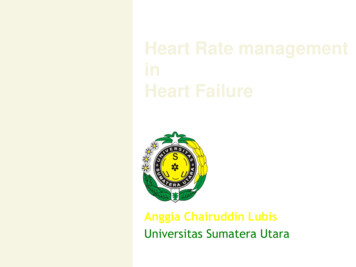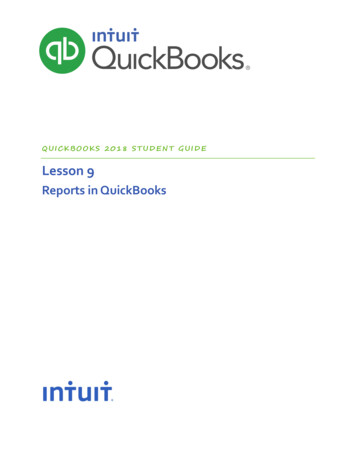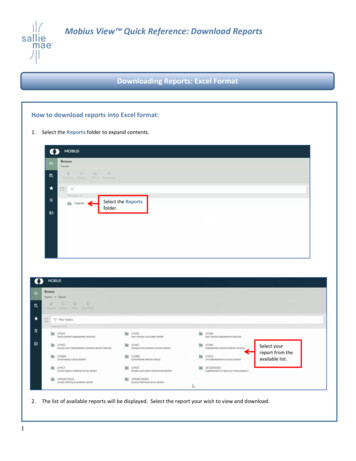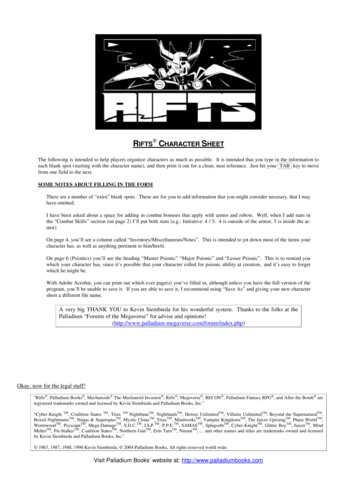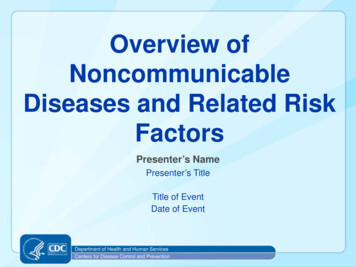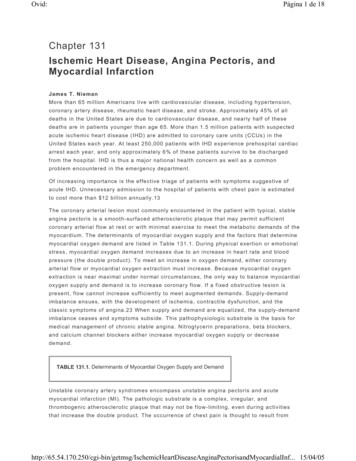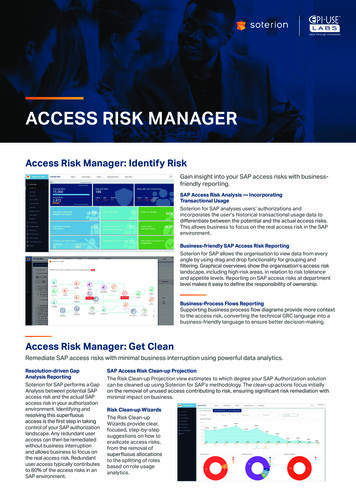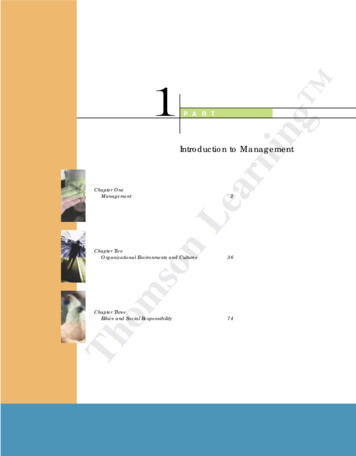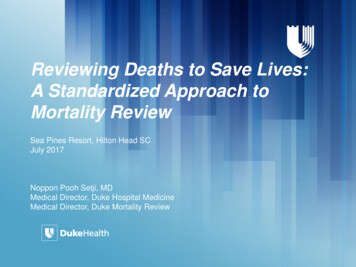
Transcription
Reviewing Deaths to Save Lives:A Standardized Approach toMortality ReviewSea Pines Resort, Hilton Head SCJuly 2017Noppon Pooh Setji, MDMedical Director, Duke Hospital MedicineMedical Director, Duke Mortality Review
Disclosures None
Questions for you How many of you have a process toreview mortality at your home institution? Do you review every death? Do you have a process to review safetyevents?
Agenda1. Importance and role of mortality review2. Approaches to reviewing deaths3. Implementation of comprehensivemortality review at DUHS4. Conclusions: Challenges and lessonslearned
Why is Mortality Review Important? An important measure ofthe quality of care– Patients and providers Growing reportingrequirements– Significant factor in hospitalbased reimbursement Patient death due tomedical error is a leadingcontributor to mortality inUS hospitals– Unclear how many deathsare preventable No consistent process forreviewing mortality
Reported Mortality MetricsMeasureRisk AdjustedPublicly ReportedCMS: 30-day Mortality for AMI,HF, PN, STK, COPD AHRQ PSIs: Death in LowMortality DRGs, SurgicalPatients with TreatableConditions AHRQ IQIs: Deaths following 15surgical procedures and 2compositesFinancial Implications (AMI only)Leapfrog: Deaths followingAVR, AAA Repair,Pancreatectomy,Esophagectomy UHC/Vizient: Ratio of Observedto Expected Deaths US News and World Report:30-day mortality rates for 12specialties
Preventable Inpatient Mortality IOM Report: To Err Is Human (1999)1– 44,000-98,000 preventable deaths/yr JAMA (2001)2– 6-23% of deaths potentially preventable– 6-61 preventable deaths/10,000admissions BMJ Qual & Saf (2012)3– 5.2% of deaths potentially preventable(NHS)– 12,000 preventable deaths/yr (UK) Journal of Patient Safety (2013)4– 200-400K preventable deaths/yrMedical errors 3rd leading cause of death in the US1Instof Medicine, 19992001; 286 (4): 415-203BMJ Qual & Saf, 2012; 21: 737-454J Patient Saf, 2013; 9 (3), 122-282JAMA,
Would you get on this plane?
Agenda1. Importance and role of mortality review2. Approaches to reviewing deaths3. Implementation of comprehensivemortality review at DUHS4. Conclusions: Challenges and lessonslearned
Reviewing Deaths:Going Behind the NumbersAdministrativeDataMorbidity andMortalityConferences(M&M)CentralizedChart rstand Drivers of Mortality and Provide Actionable Information
Administrative Data Low-cost way to provideareas of concern anddirection, but often requiresfurther chart reviewMortalityMeasurementChallengesRaw inpatientmortalityNot risk-adjusted Potential categories:– Deaths in low risksurgeries– Areas with high numberof early deaths(LOS 2 days)– Cases with codedcomplications– Areas that account forthe greatest numbers ofdeaths– Areas with the highestmortality O/E ratio30-day mortalityDifficult to track oncepatient leaves thefacilityRisk-adjusted/Standardizedmortality ratesRisk-adjustment oftendoes not take intoaccountpreventability andend of lifepreferences.Risk-adjustmentmethodologydepends on accurateadministrative data.
Morbidity and Mortality Conferences Traditional forums attended by physiciansto discuss specific aspects of cases withcomplications (including deaths) Tend to be more focused on clinicianeducation rather than systems-basedissues and solutions Can be challenging to spread lessonslearned from one department to anotherdepartment
Centralized Chart ReviewStandardizedReview ToolPatient LevelDataResourceIntensiveRequires use of institution-specific or other establishedmortality review tool (e.g., IHI 2x2 Mortality Matrix, Global Trigger)Can help point out case-level and system-leveldrivers of mortality, if documented in the recordCentralized review of all cases can be costly (staff)and requires dedicated time
Front Line Provider Review ProcessInpatientDeathAutomaticE-mail sentto reviewerReviewcompletedvia webSecondaryreview ofcases ofconcernAll dataaggregated& reportedReview Content Selected ComplicationsDelaysTeamwork and CommunicationEnd-of-life related information Short clinical summaryOpinion on preventabilitySuggestions for improvementAbility to request peer support orfurther follow-up
Advantages of Front Line Provider Review Front line clinician input from providerswho cared for patient directly Issues from case not available throughchart review or administrative data alone Distributes process of review to allow foridentification and focus on a subset ofcases
Duke University Health System: Facts and lDukeHome althSystemDukePrimaryCareStaff: 1,925 Faculty 1006 Residents and FellowsPatient Care: 160K ED visits/year 65K inpatientadmissions/year 90K surgical cases/yearServe 750,000 unique lives through Duke Health
Background on Mortality Review at DUHS Process for mortalityreview decentralized,Inconsistent tiesback to PatientSafety, RiskManagement &Peer Review
Agenda1. Importance and role of mortality review2. Approaches to reviewing deaths3. Implementation of comprehensivemortality review at DUHS4. Conclusions: Challenges and lessonslearned
Organization of DUHS Mortality ReviewDUHS MortalityReviewDocumentationReviewClinical CareReviewProviderMortalityReview ToolAggregateTrendingProviderFeedbackReview ofModels(UHC/CMS)ClinicalDocumentationImprovement
Mortality Reporting Governments and patients evaluate ahospital's quality of care by looking atperformance data Mortality is measured by mortality index:observed deaths/expected deaths Expected deaths are influenced bypatients’ characteristics which impactresource utilization and clinical outcome Patients’ characteristics are judged bytwo measures: Risk of Mortality (ROM)and Severity of Illness (SOI) Higher scores in ROM and SOI reflectsthe increased difficulty and costsinvolved in treating the patient and thehigher likelihood of poor outcomes
A Gap Exists that Needs to be BridgedProviderdocumentation iscaptured inCLINICAL termsThere is abreakdownbetween the twoseparatelanguagesDocumentation forcoding, profiling &compliance requiresspecificity in DIAGNOSIStermsClinical Documentation Excellence Helps toBridge the Gap
Review of Expected Mortality Accurate reflection of our patients true severity ofillness and risk of mortality requires:– An active clinical documentation improvement (CDI)program– Providers’ education and engagement– Active review of expected mortality by medical andcoding leadership Two layers of reviews:– Review by the CMO of each hospital– Committee review of all mortality cases with ROM/SOIless than 4, pre-bill Committee includes Medical Leadership, Coding Director, CDIDirector and Analysts Involves real-team coding while adding diagnoses found onchart review
Provider Mortality Review Tool
Goals of DUHS Inpatient Mortality Review Review all Inpatient Deaths Identify system-wide issues for improvement Initiate and guide improvement efforts toreduce inpatient mortality Measure number of preventable deaths Improve Departmental/Divisional M&MReview process
DUHS Mortality Review ProcessPatient death Death identified Notification sent todischarging providerwithin 24 hours Secure email withlink to online toolDeath reviewed bydischarging provider Uses onlinestandardizedmortality instrument Meant to becompleted frommemory Data collected incentralized database
DUHS Mortality Review ProcessEmail Notification to Provider
Online Mortality Tool
Standardized Mortality Questionnaire Brief summary ofcase Identify additionalreviewers Risk ManagementReferral Review for:––––Preventable issuesSystem IssuesUnanticipated deathsEnd of Life Care
DUHS Mortality Review Process (cont)Independent review ofdeath Centralized reviewby mortality teamfor reviewspotentiallypreventable issue orreviews that meetadditional triggersData aggregated athospital and healthsystem level Gauge # of possiblypreventable deaths Identify trends andopportunities forprocessimprovementPerformanceimprovement Share best practicesacross healthsystem Developperformanceimprovementefforts atdivision/CSU orsystem level
Reporting Structure Risk Management Mortality ReviewTeam at eachhospital site– Tied into entity peerreview infrastructure Peer ReviewProtected– Defined locally Non discoverable
DUHS Mortality Review Executive SummaryDischarge Dates: 7/1/15 – 12/31/16
Sample Case68 yo M with history of multiple myeloma for6 years who is admitted to the hospital withshortness of breath worsening over the pastmonth and occasional fevers.Patient is in remission and doing well fromhis MM standpoint overall but is fairlydeconditioned and has some signs ofdementia.
Sample Hospital CoursePatient was seen in the ED by Dr. ED. He wasadmitted to Dr. Hospitalist after having a cxrshowing bilateral infiltrates.Empiric abx with vancomycin/zosyn/azithro andtamiflu were started. Over 24 hours he hadincreasing oxygen requirements.The next day he was transferred to the ICU andcared for by Dr. Critical Care. In the ICU heultimately was intubated for 2 days.
Sample Case ContinuedA family discussion was held and the patientwas made comfort care and extubated.He was transferred to the floor toDr. Palliative where he passed away 6 hourslater.1 month later autopsy shows PCPpneumonia.
Review Process in ActionDeath OccursEmail Discharge gged forRiskManagementSent to iewersNeeded?Systemsissuepresent?No issuesand notpreventableMortality Review Team WorkQueue
Mortality Team Review Work Flow
Death Perspectives Dr. ED – the patient was alive when I sawhim Dr. Hospitalist – I thought he should haveresponded to the antimicrobials Outpatient Provider – Nobody told me hewas admitted Dr. Palliative– death was expected Autopsy – Path results a little surprising
Mortality Team in Action Path results spur independent review orexpert review request Case review findings show a couple of MMpatients who die of PCP in last year Patient Safety Flag sent to Infection Controland to Liquid Tumor teams to review Liquid Tumor team advises M&M reviewlocally at their division mortality/safetyconference
Mortality Team in Action Liquid Tumor team brings their “lessonslearned” to our monthly JEDI council These lessons are captured in ourmortality digest for dissemination CMO meets monthly to discusstrends/patterns and to devise action planto address this potential systems/safetyissue
Mortality Team Activities Opportunities for improvement shared withservice line leaders Aggregated data helps to identify trendsand targets for health system safetyprojects
DUHS Mortality Review SAMPLE DataSimulated data for presentation purposes only
Project Work Direct ED-Hospice Admissions Focus on increased palliative care supportdirectly from clinics Evaluation and revision of DNAR process Identification and prevention of inpatientdelirium Aspiration prevention Earlier Advance Care Planning
Sample ReportsSimulated data for presentation purposes only
Comprehensive Review of MortalityAdministrativeData/UHC*US News*RL6DocumentationReview*MortalityReview Reports*PSIsComprehensiveReview ofMortality* Indicates first wave of integrationHAIsMultiple sourcesof informationwithin healthsystem thatserve as“listening posts”for theidentification ofpatient safetyand performanceimprovementopportunities
Comprehensive Mortality ReviewFilters to drilldown to specificareas of interestFilters for specificpatientpopulations(Expandable) Transfers USNWR Exploringproceduresand diagnosiscodesLink to relateddashboards withmore detailedinformationMortality basedmetrics to offermid level viewof hospitalperformance
NO State Secrets UCLA experience 6% potentiallypreventable; 55% with systemopportunities for improvement 4 main categories: advanced careplanning, communication and teamwork,systems issues and delays in recognitionof deterioration
Penn Experience is Similar Observed mortality reduced from 2.45% to1.62% after mortality review created in2006 Opportunities identified in deliriummanagement, aspiration pneumonia andsepsis
Agenda1. Importance and role of mortality review2. Approaches to reviewing deaths3. Implementation of comprehensivemortality review at DUHS4. Conclusions: Challenges and lessonslearned
Implementation Challenges Dependent on quality of provider input– Independent adjudication of case findings is important Impact of Culture– Physician buy-in to the process Technical aspects & cost to build and manage Mitigating risk and peer review protections Creating strong ties to Performance Improvementwork How to “harmonize” administrative &documentation data with clinical care data
Future Directions Addition of other review types (i.e., nurse,pharmacist, autopsy) Continued development of independentadjudication Further integration with patient safety/qualityimprovement operational work and M&Ms Continue to “harmonize” data streams to providethe comprehensive overview of care deliveryopportunities Enhancing feedback to providers Focus on Second Victim
Summary Consistent and systematic review of mortalityimportant for identifying system issues andkeeping patients safe Requires a focus on documentation and clinicalcare delivery Helps to identify multiple targets for improvement Strong leadership support is a prerequisite Data dissemination is essential– This includes feeding back data to providers Need an improvement infrastructure to respond toyour data Frontline provider perspective is invaluable
Questions/CommentsNoppon Setji (Noppon.Setji@duke.edu)
APPENDIX
SOI/ROM Scores Depend on Accurate Documentation Provider’s documentation mustcapture all co-morbidities, organmalfunction and hospitalizationevents Provider’s documentation istranslated from words into a seriesof codes Based on Interaction amongSecondary Diagnoses and comorbidity These codes are submitted inclaims and are the basis for allquality metrics
Capture of True SOI/ROM Accurate reflection of our patients trueseverity of illness and risk of mortalityrequires:– An active clinical documentation improvement(CDI) program– Providers’ education and engagement– Active review of expected mortality by medicaland coding leadership
Accurate Mortality Reporting Reflecting the true quality of care is criticalto:– Patients– Providers– External reporting agencies Must engage providers, medicalleadership and coding leadership
Mortality Review Models UCSF– Centralized multi-disciplinary committee– Cases referred for review Mayo– All deaths reviewed independently by both nurse and MD– All deaths discussed at monthly mortality review meeting;presented by nurse/MD Brigham & Women’s– Provider based review– Monthly review of subset of cases with system issuesidentified and/or scored as possibly/likely preventable;cases presented to multidisciplinary committee
Review Tool Resource Intensive Patient Level Data Can help point out case-level and system-level drivers of mortality, if documented in the record Requires use of institution-specific or other established mortality review tool (e.g., IHI 2x2 Mortality Matrix, Global Trigger) Centralized review of all cases can be costly (staff)
